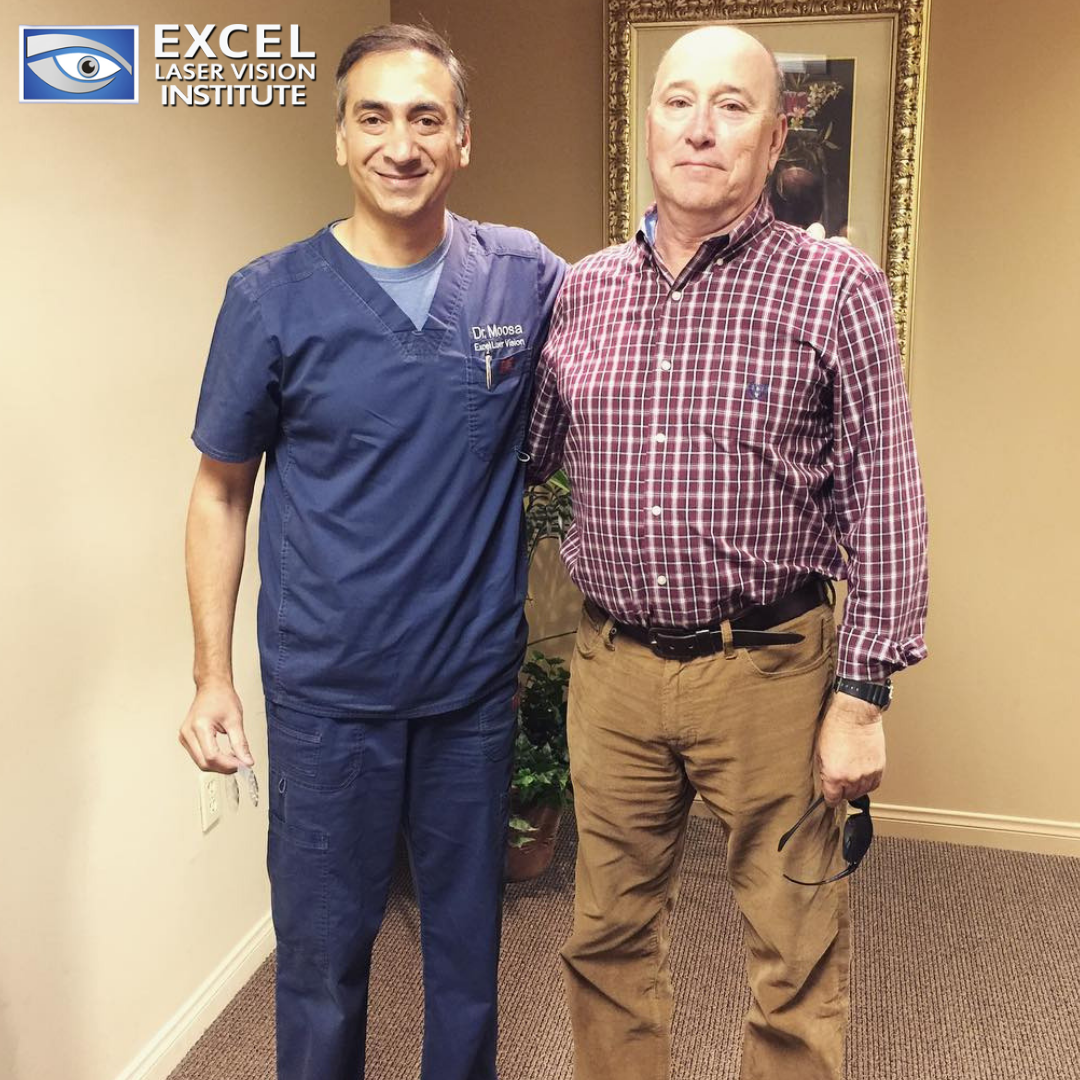
When You Consider Lasik Eye Surgery Cost, You Have to Think About Additional Surgery
When you are budgeting for the LASIK eye surgery cost, you have to consider keeping extra funds aside for a LASIK enhancement in Los Angeles. A LASIK enhancement is a follow-up LASIK procedure that every so often is performed if the outcome of your initial vision correction surgery is insufficient or if your vision changes to some degree over time.

Determining Visual Satisfaction After LASIK
Several circumstances can affect your satisfaction after LASIK such as:
- The quality and health of your corneas
- If you are nearsighted, farsighted or have astigmatism
- How bad your refractive error is and the strength of your eyeglass or contact lens prescription
- If you are at risk for dry eyes after LASIK
- Your age
- Your expectations
The majority of LASIK procedures in Los Angeles successfully correct high degrees of nearsightedness, farsightedness, and astigmatism. Younger people with mild nearsightedness and astigmatism usually are the best candidates for a good result, so their LASIK eye surgery cost usually does not go beyond what they forecasted for the procedure.
What you expect before LASIK is also an important factor in how satisfied you will be afterward. You must keep in mind that the goal of LASIK is to reduce your need for glasses and help you see very well without corrective lenses. However, outcomes vary from person to person.
Although many people who have had LASIK claim to see better than they did with glasses or contact lenses before surgery, not everyone will have the same results.
A small percentage of people may realize that their vision isn’t as good after LASIK as it was when they wore glasses or contacts before the procedure. LASIK enhancement would be a necessary procedure in these cases so it is essential to plan for the possibility when considering the LASIK eye surgery cost.
When Do You Require LASIK Enhancement?
You shouldn’t panic if your vision isn’t as perfect as you expected it to be right after LASIK surgery. Everyone’s eyes are different and respond differently to different techniques.
When you are assessing your vision after LASIK, you should take some time to let your eyes heal to really notice if there is a significant visual improvement. Although you should be able to see a lot better without glasses the day after surgery, it isn’t uncommon for vision to ebb and flow for several weeks while your eyes adjust.
A factor of your follow-up care after LASIK is that your Los Angeles doctor will examine your vision for several weeks to months.
Although uncommon, you may feel uncomfortable driving or performing other visual tasks after LASIK. If this happens, make sure to tell your ophthalmologist. If needed, he or she can prescribe new eyeglasses for you to wear for a short period of time until your vision improves and adjusts to the results of the procedure.
If after three months of LASIK you still notice that your vision is blurry, you may need to speak to your surgeon about an enhancement.
To decide if you are a good candidate for a LASIK enhancement, your eye doctor will re-examine your corneas with the same methods used previously for your first LASIK procedure.
Besides other concerns, your optometrist will check to see if you have enough corneal thickness for a second surgery.
If after your LASIK procedure, there is very little refractive error to fix with another laser treatment or you are not a good candidate for a LASIK enhancement procedure, wearing eyeglasses on a part-time basis might be advantageous to sharpen your vision when required.
To get the best comfort and clarity, most ophthalmologists recommend that you choose eyeglass lenses with anti-reflective coating. This coating removes distracting reflections and supports sharper vision in low-light conditions such as driving at night.
A lot of people feel that wearing progressive lenses provide much comfort and convenience after LASIK because these line-free multifocal lenses give clear vision at any distance without having to carry a separate pair of reading glasses.
It could also be beneficial to look into investing in high-definition lenses that can correct higher-order aberrations that regular eyeglasses cannot address.
If you find that you are sensitive to light after LASIK surgery, request for photochromic lenses that darken automatically when exposed to sunlight for better comfort when you go outdoors.
How Does A LASIK Enhancement Compare To A Primary Lasik Procedure?
A LASIK enhancement is almost the same as a primary LASIK procedure, except for one thing. Instead of using a microkeratome or laser to create a corneal flap, the Los Angeles surgeon performing a LASIK enhancement utilizes special tools to lift the flap that was created on your eye’s surface during the primary LASIK surgery.
No pain is involved when the flap is re-lifted and it usually takes only one or two minutes. Next, your surgeon uses an excimer laser to reshape your cornea.
Normally, only a slight additional reshaping of the cornea is necessary during an enhancement. Therefore, this laser treatment should only take a few seconds.
Once the enhancement is complete, you will receive the same post-operative instructions that you were given after your primary LASIK procedure.
Make sure to follow your doctor’s instructions to lower the risk of eye infection and ensure you have a good outcome.
In most circumstances, only one LASIK enhancement is required to restore vision to an adequate level. Unfortunately, in more difficult cases, more than one enhancement might be needed to achieve this.
How Much Does Enhancement Laser Eye Surgery Cost?
Many eye surgeons do not charge an extra fee for LASIK enhancements that are performed within one year of the primary LASIK procedure that they performed themselves. However, pricing policies differ immensely among refractive surgeons and eye surgery clinics.
If you had LASIK surgery and are not satisfied with the results, contact Excel Laser Vision Institute at + (818) 907-8606 today. Our trained Los Angeles eye surgeons can quickly determine whether you require a LASIK enhancement.
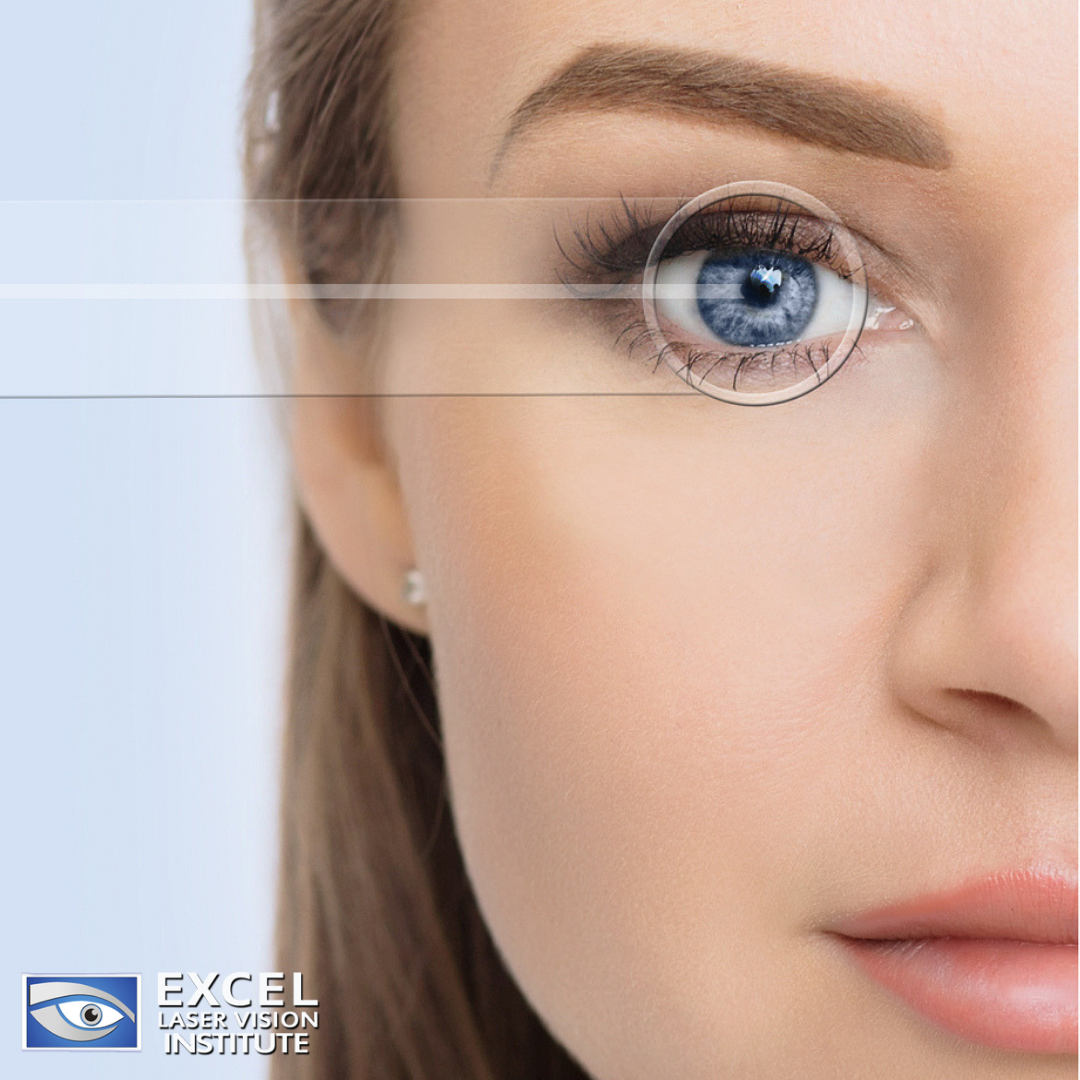
How Does LASEK Eye Surgery Work?
Many people have heard a lot about LASEK eye surgery at the LASIK eye center in Los Angeles, but not many people know what LASEK surgery actually is. In a nutshell, LASEK eye surgery is a variation of PRK to correct myopia (nearsightedness), hyperopia (farsightedness) and astigmatism.LASEK is a combination of particular methods from both LASIK and PRK.

LASIK is still the most popular laser eye procedure in Los Angeles, but for those who are not the right candidates for LASIK or PRK, LASEK can be a better option and even produce the same results as LASIK. Similar to other types of laser refractive surgery, LASEK works by reshaping the cornea using an excimer laser. This lets light enter the eye correctly to properly focus onto the retina for clearer vision without the need for eyeglasses or contact lenses.
The essential difference in how LASIK, PRK, and LASEK are performed depends on how the eye is prepared for laser treatment:
LASIK: During the LASIK procedure at the LASIK eye center in Los Angeles, a thin circular flap is created on the eye’s surface using a microkeratome or a femtosecond laser surgical tool. The eye surgeon then folds back the hinged flap to access the stroma and reshape the corneal tissue with an excimer laser. Then, the flap goes back to its original position and acts as a natural bandage, keeping the eye comfortable while it heals. The flap attaches securely without stitches, and healing happens very quickly.
PRK: During PRK, a corneal flap is not created like it is in the LASIK procedure. Instead, the surgeon completely removes the paper-thin outer layer of the cornea called the epithelium, which is a clear “skin layer” covering the cornea, by using an alcohol solution, a “buffing” tool or a blunt surgical tool. The surgeon reshapes the underlying corneal stroma with an excimer laser. Five days after the PRK procedure, a new epithelial layer grows back.
One other type of laser eye surgery worth mentioning is epi-LASIK or e-LASIK, which is almost identical to LASEK. Rather than the use of alcohol to lessen the epithelium, which is the case in LASEK, in epi-LASEK the surgeon usually uses a blunt, plastic blade to separate the epithelial sheet from the eye. This prevents the likelihood of a reaction from the alcohol, which can destroy epithelial cells.
If you are concerned about high success rates and similar vision results, LASIK, PRK, and LASEK all have high success rates. One is not better than the other in the long run, and it ultimately all depends on what the right procedure is for your eyes specifically.
Your LASIK eye surgeon in Los Angeles will let you know about the best type of laser eye surgery for your requirements after a thorough eye exam.
What’s The Difference Between LASEK vs LASIK?
At the LASIK eye center in Los Angeles, the hinged flap made in LASEK surgery is made in the epithelial layer of the eye and is much thinner than the corneal flap made in LASIK, which consists of both epithelial and deeper stromal tissues. This is important if you naturally have a thin cornea as that would not make you an ideal candidate for LASIK.
The LASEK method prevents any corneal flap related LASIK complications and reduces the possibilities of removing too much cornea with the excimer laser and weakening the structural integrity of the eye. By evading a deeper flap, there is also a smaller risk of developing dry eyes after LASEK eye surgery.
If you have severe myopia, LASEK may be a better option since myopia requires more tissue removal from the central cornea to correct the refractive error. LASEK may also be the best procedure for you if your occupation or hobbies put you at high risk of an eye injury and disturbing the corneal flap created in LASIK surgery.
What’s The Difference Between LASEK vs PRK?
LASEK is very much like PRK. Both procedures consist of lifting a very thin epithelium layer to access deeper corneal tissues, rather than creating a thicker corneal flap as in LASIK surgery.
The main difference between LASEK and PRK is that LASEK maintains and replaces the epithelial layer while in PRK the epithelium is completely removed and disposed of to enable a new epithelial layer to grow back over the next few days after surgery.
What To Expect From LASEK Eye Surgery?
When you have chosen an eye surgeon you feel comfortable with to do the procedure for you, he or she will perform a thorough eye exam and general health check to see if you are a suitable candidate for LASEK eye surgery.
If you usually wear contact lenses, your doctor will typically advise you to stop wearing them for a few days before taking the assessments for laser eye surgery since contacts can change the natural shape of your cornea.
After your surgery, you won’t be able to drive yourself home, so you will need to arrange for someone to drive you. You will also have to schedule some time off of work, usually about a week in most cases, because your eyes need time to heal so your vision can start to improve.
During the surgery, numbing drops are applied to your eye. When your eye is numb, the surgeon can begin to make a circular cut in the corneal epithelium using a fine blade called a trephine.
The trephine leaves a small arc-shaped area of the circle uncut, that way the epithelial flap that is created stays attached to the eye. Then a diluted alcohol solution is put over the eye for about 30 seconds, which loosens the edges of the epithelium and helps the surgeon to carefully push the loosened flap of the epithelium to the side.
The excimer laser is placed over the eye to reshape the corneal stroma and correct the vision condition. Once the laser treatment is over, the epithelial flap is repositioned on the eye. A special contact lens that acts as a protective bandage is then put over the eye.
LASEK usually takes only 15 minutes per eye and is done on a walk-in, walk-out basis. You are awake for the procedure and you won’t feel any pain!
Consult with your refractive surgeon for the eye surgery procedure that works best for you. If you want further information about LASEK, LASIK, and PRK, give Excel Laser Vision Institute a call at + (818) 907-8606 today.
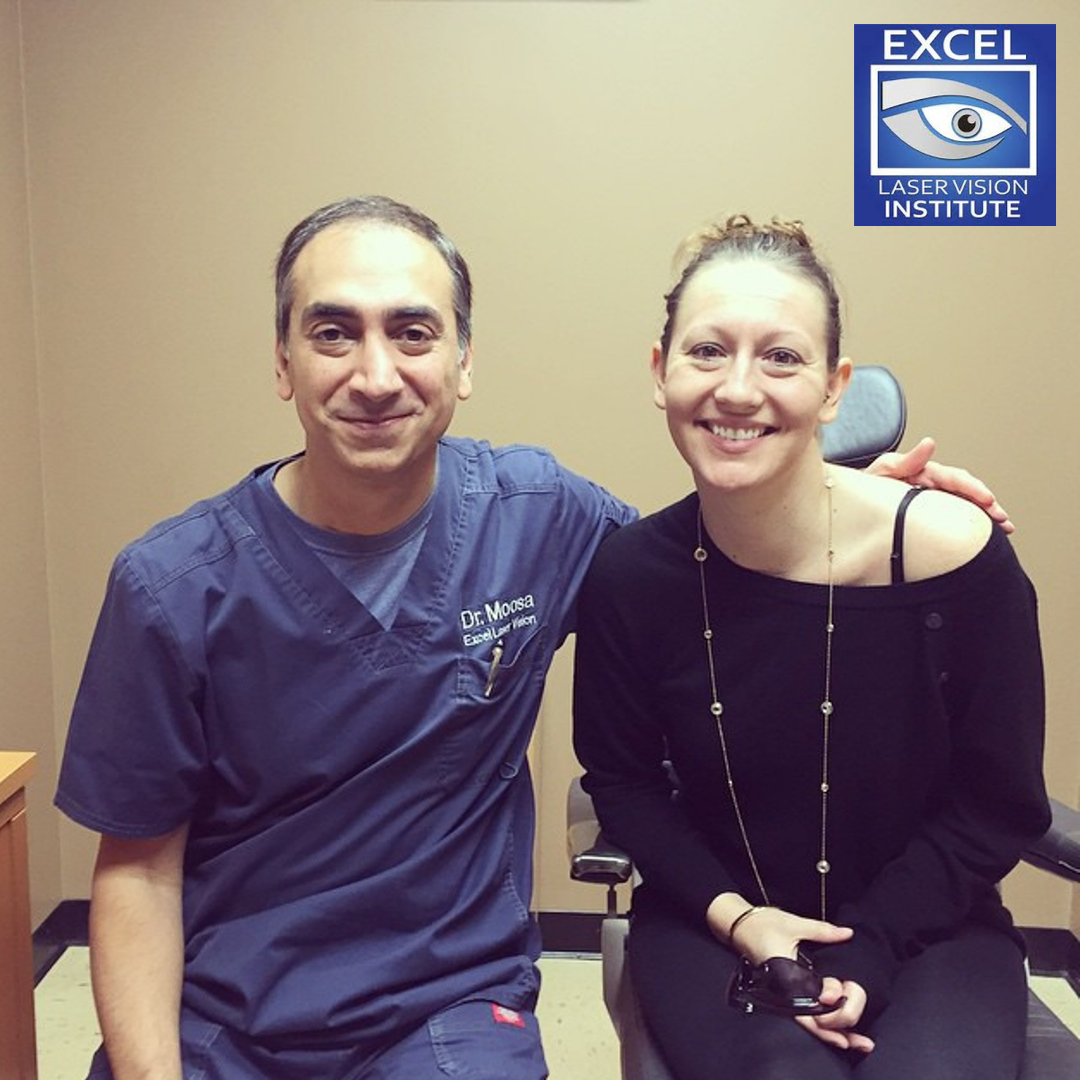
How the LASIK Surgeon Performs Your LASIK Eye Surgery
Nowadays, LASIK eye surgeons in Orange County are in high demand to treat myopia (nearsightedness), hyperopia (farsightedness) and astigmatism, using one of the most popular procedures to date, LASIK.

What Is LASIK Eye Surgery?
LASIK is an acronym for “laser-assisted in situ keratomileuses”. Lasik eye surgery is a refractive surgery that reshapes the cornea to help light enter the eye correctly onto the retina, usually resulting in clearer vision.
LASIK surgery is typically painless and takes about 15 minutes for each eye, depending on the level of correction that needs to be done. The end result you should expect at Excel Laser Vision Institute, a LASIK clinic in Orange County is typically better vision without eyeglasses or contact lenses. Your vision also should continue to improve and stabilize over the following days after LASIK.
It is possible for you not to qualify as a good candidate by a LASIK surgeon in Orange County, however, there are other vision correction surgeries available such as PRK, LASEK, and PIOL surgery.
It is a good idea to set up an appointment with an ophthalmologist to ascertain which vision correction surgery is best for you.
What Happens During LASIK Surgery?
For the most part, there are three steps in a LASIK procedure, which are:
- A flap in the cornea is created.
- The underlying corneal tissue is reshaped with a laser.
- The flap is then relocated back over the treated area.
LASIK eye surgery ultimately corrects your vision by reshaping the cornea, which is the clear front surface of the eye.
In detail, a LASIK surgeon in Orange County will numb your eye with anesthetic drops. When the drops take effect, the eye surgeon will directly mark your eye for the realignment of the corneal flap after the laser treatment.
The surgeon will then place a suction ring to hold your eye steady while they create a thin flap in the cornea. This flap can also be created with a laser for a blade-free LASIK procedure.
The flap is folded back but is still attached to the eye by a small uncut hinge on one side. A computer-controlled laser beam is then used to reshape the cornea in less than one minute. Then, the corneal flap is repositioned and fixes to the underlying cornea without any stitches!
After LASIK surgery, the reshaped cornea should provide clear vision without the need for glasses or contact lenses. LASIK eye surgery only uses topical anesthetic drops, and bandages or stitches are not required after the procedure.
What Happens Before LASIK Surgery?
An optometrist will perform a thorough eye exam to make sure your eyes are healthy enough for the LASIK procedure. To do this the eye doctor will evaluate the shape and thickness of your cornea, pupil size, refractive errors (myopia, hyperopia, and astigmatism) and other eye conditions.
The eye doctor will also have a look at the tear film on the surface of the eyes, and a precautionary treatment might be recommended to lower your risk of developing dry eyes after LASIK surgery.
Generally, an automated instrument called a corneal topographer is used to measure the curvature of the cornea and to create an outline of it.
Since wavefront technology is linked with custom LASIK, you will most likely undergo a wavefront analysis that transfers light waves through the eye to support a precise outline of aberrations affecting your vision.
When being examined by your eye doctor to see whether LASIK is the right laser eye surgery for you, he or she will ask you about your general health history and any medications you are currently taking.
The doctor will also advise you to stop wearing contact lenses for an amount of time (usually two weeks) before your eye exam and before LASIK surgery because contact lenses can temporarily stop the natural shape of your cornea.
What to Anticipate During LASIK Surgery?
Before your eye surgeon starts the LASIK surgery procedure, you will receive numbing eye drops to ward off any discomfort during the procedure. If you are feeling anxious, your doctor might give you some medication to help you relax.
The surgeon will place your eye under the laser, and an instrument called a lid speculum is used to keep your eyelids wide open. Then, the eye surgeon moves on to marking your cornea before creating the flap. A suction ring is placed on the front of the eye to prevent eye movements or loss of contact that could affect flap quality. You shouldn’t feel any discomfort during these steps.
After the eye surgeon creates the corneal flap, he or she uses a computer to modify the excimer laser for your specific prescription.
Your surgeon will ask you to look at a target light for a short time while he or she watches your eye through a microscope and a laser sends pulses of light towards your cornea.
These laser light pulses painlessly reshape the cornea, even though you might feel some pressure on the eye. You will constantly hear a clicking sound while the laser is operating. The LASIK surgeon performs the LASIK procedure on each eye separately, and each procedure takes about 5 to 10 minutes depending on your condition.
What Happens Right After LASIK Surgery?
When the LASIK procedure is completed, your eye surgeon will let you rest for a while. You might feel a temporary burning or itching sensation right after the procedure.
After you get a brief post-operative exam, your designated driver can take you home. It is important to note that you cannot drive yourself home after LASIK surgery until your optometrist sees you the next day and confirms that your corrected vision is in line with the legal standard for driving.
If you experience blurry vision and haziness right after your surgery, do not be alarmed because that is normal. Nevertheless, you should start to have some clarity the next morning.
Throughout the following days after your laser eye surgery, your eyesight should stabilize. There are some rare instances where a person’s vision takes several weeks or longer, but for the majority of people, their vision improves straight away.
If you would like to know more about LASIK eye surgery and find out if you are a potential candidate, contact Excel Laser Vision Institute at + (818) 907-8606 today. Our trained eye surgeons can accurately assess you for LASIK surgery and provide you with outstanding results!

What Are The Causes And Treatment Options Of Myopia?
Nearsightedness, or otherwise known by its medical term, myopia, is a very common vision condition that many people under the age of 40 suffer from. The center for LASIK in Los Angeles has reported that patients that have myopia don’t usually struggle when it comes to seeing objects near them, however, objects that are farther away typically appear blurry. Recently, there has been a noted increase in people diagnosed with myopia.

What Is Myopia?
Research across the world has concluded that by the year 2050 about 25 percent of the world’s population will be nearsighted. If you suffer from nearsightedness, you will probably find it challenging to read road signs and make out distant objects clearly, but you can typically see pretty well when you look at objects close up and do tasks such as reading and computer use.
Here are a few common symptoms of myopia:
- Problems seeing when driving, particularly at night (night myopia)
- Squinting or partially closing your eyelids just to see clearly
- Headaches typically because of eyestrain
- Blurry vision when trying to look at distant objects
- Feeling tired when driving or playing sports
If you relate to any of these symptoms, while already wearing contact lenses or glasses, you should schedule an eye exam at Excel Laser Vision Institute, a clinic of LASIK in Los Angeles to check if you need a stronger prescription.
What Causes Myopia?
Myopia is usually diagnosed during childhood, between early school years through teenage years. A child that suffers from nearsightedness may exhibit these symptoms or signs:
- Frequent rubbing of his or her eyes
- Sitting close to the television, movie screen, or front of the classroom
- Always squinting
- Not aware of distant objects
- Excessive blinking
Myopia is simply caused because of the eye’s structure and development. If you have an eyeball that is too long or the cornea (the protective outer layer of the eye) is too curved, the light that enters the eye cannot focus properly. When this is the case, images focus in front of the retina (the light-sensitive part of the eye), rather than directly on to the retina. This often results in blurry vision. Ophthalmologists of LASIK in Los Angeles called this a refractive error.
What is a Refractive Error?
When the cornea or lens is uneven and isn’t smoothly curved, light rays are unable to refract correctly, and that is when a refractive error occurs.
Myopia is not the only eye condition that develops from refractive errors. Other forms of refractive errors can be:
Astigmatism: This happens when the cornea or lens is curved more perpendicularly in one direction than in another. When astigmatism is left uncorrected, the individual typically experiences blurred vision.
Farsightedness (hyperopia): This happens when the eyeball is shorter than average or the cornea is curved too insufficiently. This results in the opposite of nearsightedness. In adults, near and far objects typically appear blurry.
Despite the simplicity of refractive errors, there are more serious and rare forms of myopia that can be diagnosed, such as:
High myopia: This is a severe form of myopia in which the eyeball grows more than it should and becomes very long from the front to the back. Along with the difficulties of seeing objects at a distance, it can bring about an increased chance of having other eye conditions such as cataracts, a detached retina, and glaucoma.
Degenerative myopia: This is also known as pathological or malignant myopia. It is a rare form of myopia that is usually inherited from a person’s parents. The eyeball gets longer faster and causes severe myopia, usually by teenage or early adult years. Additionally, this type of myopia can worsen when into adulthood. Apart from having issues seeing things at a distance, you may have an increased chance of getting a detached retina, glaucoma, and abnormal blood vessel growth in the eye (choroid neovascularization).
Are There Risk Factors for the Development of Myopia?
There are risk factors that can increase your possibility of developing nearsightedness, such as:
Environmental conditions: Research has shown that a lack of time spent outside may increase a person’s chances of developing myopia.
Reading and close-up work: Those who do a lot of reading, writing or computer work are more likely to develop myopia. Spending a lot of time playing video games or watching television and holding reading material too close has been linked with increased chances of developing myopia.
Genetics: Nearsightedness is usually inherited and runs in families. If one of your parents is nearsighted, the risks of you developing the condition is increased. Your risk is even higher when both of your parents are nearsighted.
How is Myopia Diagnosed and Treated?
An eye exam at Excel Laser Vision Institute, a LASIK eye center in Los Angeles can quickly diagnose your myopia. If you are diagnosed with nearsightedness, eyeglasses, contacts, or refractive surgery can usually correct the problem.
When a person has myopia, the prescription for glasses or contact lenses will be a negative number. The more negative the number, the more powerful the lenses will be. For instance, -5.00 is stronger than -1.50.
The prescription helps the eye focus light on the retina, which can clear up a person’s vision. However, eye surgery can improve a person’s myopia to a point where they won’t need to wear glasses or contacts anymore. The most common procedures for myopia are:
Photorefractive Keratectomy: This is also known as PRK, and is a surgery that uses a laser to sculpt the middle layer of the cornea. This flattens the cornea’s curve and allows the light rays to focus closer to or on the retina.
LASIK: Laser eye surgery is the most common surgery for myopia. The eye surgeon uses a laser or another tool to make a thin flap on the top layer of the cornea. Then the surgeon sculpts the cornea with another laser and moves the flap back into place.
If you suspect you have myopia or are interested in LASIK eye surgery to correct any vision impairments, contact Excel Laser Vision Institute at + (818) 907-8606 today. Our trained eye doctors can quickly assess you for myopia and inform you of the best options, including the LASIK procedure.

How To Cure Your Dry Eyes
Los Angeles can have some extreme temperature fluctuations which may cause some people to develop irritated and dry eyes. Some patients tell their LASIK surgeons that they are experiencing dry eyes even more so after their LASIK surgery. As a matter of fact, studies reveal that about half of the people who undergo LASIK, have some level of dry eyes after the procedure. These symptoms can continue for weeks, months, or even longer.

Although LASIK potentially can cause a bit of dry eye, sometimes LASIK can help dry eyes which can occur from wearing contact lenses. The best lasik surgeons in Los Angeles may suggest that contact lens wearers who are finding their lenses too uncomfortable to wear anymore because of their dry eyes, may want to consider LASIK as a way to increase comfort.
The good news is that LASIK surgeons in Los Angeles, provide screening for LASIK that helps to detect and treat dry eyes. For a majority of people who want to get laser eye surgery, they now may help their pre-existing dry eye issues when it is brought up during their LASIK consultation.
Why Do Some People Get Dry Eyes With LASIK?
A LASIK procedure involves some nerves in the cornea to be cut, which lowers corneal sensitivity to some respect. Your eye may react by thinking it doesn’t need lubrication, which results in your body producing fewer tears, and this leads to dry eye syndrome.
As a provision, you should start treatments to increase eye lubricants before your LASIK procedure even if you don’t have the symptoms of dry eye.
In some patients, where dry eyes are very severe, Los Angeles LASIK surgeons may recommend corrective vision procedures that do not require creating a thin flap on the eye’s surface, for example, PRK may be a better solution than LASIK in these circumstances.
How Do LASIK Patients Get Dry Eye Screening?
Both the characteristics and the abundance of tears you generate are determinants in the development of dry eyes, which in addition to can affect healing after eye surgery.
Since eye surgeons are more aware that the optimal LASIK outcomes might rely on controlling dry eyes, the patient will most likely have to go through a screening before the procedure.
Below are various tests for detecting dry eyes:
MMP-9 Testing – This is a painless test that your doctor will perform by collecting a small sample of your tears from the inside of the bottom lid. After a few minutes, the doctor can determine whether or not you have high levels of a protein that can cause some conflict with an inflammatory dry eye after LASIK surgery.
Imaging – Your LASIK surgeon can use Keratometers or other instruments that give an insight into the tear film without touching the eye’s surface.
Schirmer test – An ophthalmologist will place a thin strip of paper under the patient’s lower eyelid to measure tear production.
Tear breakup time – Your doctor will place a small quantity of dye on the eye’s surface to see how your tears distribute and when they begin to “break up” on the eye’s surface.
While your LASIK specialist examines you as a possible candidate for the LASIK procedure, your eye surgeon might have to assess if you have an underlying condition that is causing dry eyes as well.
Who Is At Higher Risk Of Getting Dry Eyes After LASIK?
A study conducted at the Baylor College of Medicine in Houston has proven that those who have high levels of myopia are at a higher risk of dry eyes after LASIK than people with far less severe nearsightedness before surgery.
A few other reasons for dry eye syndrome before or after LASIK are:
- Remarkably dry climates or environments, for instance, a room that is extremely heated or air-conditioned.
- Allergy medications such as antihistamines or specific blood pressure medications and antidepressants that decrease the amount of moisture in the eyes.
- Autoimmune diseases such as Sjogren’s syndrome.
- Mature age, specifically in women who have gone through menopause.
On the contrary, if your doctor finds out that you do have dry eyes before your LASIK procedure, he/she will not rule you out as a candidate. However, your eye surgeon will have to measure the seriousness of your eye dryness condition and the best effective treatments you can do before doing the procedure.
How to Treat Dry Eyes Before and After LASIK?
If your doctor has discovered you have a pre-existing dry eye condition, a LASIK surgeon may want to treat you before LASIK, or any other eye procedures, rather than eliminating you as a candidate.
Even if you do not suffer from dry eyes and you have normal tear production, your eye surgeon may still want to treat you for eye dryness before LASIK as a precaution
Your doctor may also recommend flaxseed oil or to take fish oil orally for several weeks prior to your LASIK surgery to improve your eyes’ tear film. Also, your corrective eye surgeon may prescribe eye drops such as Restasis to lower inflammation, which can help your body produce more tears.
There are other common dry eye remedies such as punctal plugs, which can block tear drainage channels to encourage moisture on the eye, and anti-inflammatory medications such as corticosteroids dispensed as eye drops.
How to Prevent Dry Eyes Before LASIK?
When you meet with your LASIK surgeon for your consultation and are aware of your dry eye symptoms, make sure to mention that and any other eye symptoms that could indicate or cause eye dryness to arise. Even tearing too much, may signify you have a dry eye issue.
Research shows that taking omega 3 fatty acid supplements and consuming foods that contain good fats such as salmon or avocado, can help maintain a healthy tear film. Also, drinking lots of water can guarantee that your body and eyes are well hydrated.
If you are considering LASIK corrective surgery and have some concerns about dry eyes, get in touch with Excel Laser Vision Institute at + (818) 907-8606 today. Our professional team of eye surgeons can assess you and may be able to treat you for your dry eye symptoms before and after your LASIK procedure.

How Cataract Surgery Can Help You Drive Safely
Many senior citizens we see at Excel Laser Vision Institute in Los Angeles for cataract surgery want to be able to maintain their ability to drive and stay independent. To assess whether or not a person is still visually capable of driving, there are laws in place. Some car insurers consider the Snellen acuity as an accurate way of measuring a person’s vision capability.

Normally, patients who are receiving cataract surgery admit that they try to limit their driving to the store down the road, avoid highways, and never drive after dusk, which only confirms to their ophthalmologist that there is a need for cataract surgery.
What Is Snellen Acuity?
When your eye doctor is assessing your need for cataract surgery, they will often use a Snellen chart, to assess your cranial nerve II, which is the optic nerve. Whenever this is performed, your ophthalmologist will place you in front of a Snellen chart and you will be required to sit or stand at least 20 feet from it. Your doctor will ask you before you start this eye test whether or not you wear glasses. If you normally do, then you will have to wear your glasses for this test.
When you are set, you will be asked to read the lowest line on the chart that you can see. You will do this by covering your right eye, then your left eye, and then reading the line using both eyes. Depending on which lines from the Snellen chart you can read, your eye doctor can easily determine your visual capability.
Although the Snellen acuity test is used throughout North America and Europe, some doctors feel that it is a poor assessment of functional vision. Nowadays, there are better measures to determine a person’s working eyesight which includes contrast sensitivity and disability glare testing.
There is a higher risk for elderly drivers with cataracts to be involved in a car accident. Also, this risk most probably will increase way before the development of a visually significant cataract is apparent. This is why testing how their eyes perform under contrast and glare can determine whether they have an underlying issue with cataracts.
Why Is Glare A Visible Disability For Drivers?
Glare can be broken down into four types: dazzling, scotomatic (like a camera flash), discomfort, and disability. Glare sources such as a car’s headlights are partly scattered in the eye. When this happens, it creates a veil of light that lies on top of the image on the retina. This is known as retinal stray light. This glare sensation depends on the amount of glare brightness and glare sensitivity of their eyes.
Disability glare happens when intraocular retinal stray light lowers visibility and visual performance. This stray light can appear from light scatter in the cornea, lens, and vitreous. The most common causes are corneal opacities, cataract, and asteroid hyalosis. It is very different from discomfort glare, which can be alleviated with sunglasses or glare filters.
A few younger people have some retinal stray light, which drastically increases with age, doubles at the age of 65 and even triples at 77 years of age. A study conducted with 2,422 drivers from five Europeans countries revealed that almost one-third of those aged 75 years and older had a disability glare or a fourfold increase in stray light.
Can You Drive With Cataracts?
As the specialists at Excel Laser Vision Institute who perform cataract surgery in Los Angeles will tell you, all types of cataracts will increase stray light, and these effects of retinal stray light are probably a patient’s first symptoms as their cataracts begin to develop. However, every individual person’s cataract is different, and when it is in its early stages it could be so small that it does not affect your vision. You might be able to drive for several years if you do not suffer from any other medical condition.
Unfortunately, in the long run, cataracts will get worse and cloud your eye lens even more, which will result in dull and blurry vision. Driving with cataracts isn’t easy and you might have to work out the best times for you to drive when your vision isn’t affected; for instance, avoid driving in rainy conditions, at night, rainy weather at night, or driving into the setting sun.
Besides having a difficult time seeing the road, cataracts make it harder for you to see street signs, other cars and pedestrians since cataracts can cloud the eye’s lens. Here are a few signs that indicate that you could have cataracts.
- Colors look washed-out
- It is difficult to see things in bright light
- Objects look blurry
- You sense headlight glare more intensely
- Seeing at night is nearly impossible
- You might have double vision
What To Do When Cataracts Affects My Driving?
Your Los Angeles eye doctor will recommend you have cataract surgery depending on the severity of your visual weakness. If you feel that cataract surgery is the best solution for you, your clouded lens will most likely be replaced with a clear artificial lens. Once you have your new, clear lens, you will be able to keep driving safely for many more years to come. Cataract surgery is usually done on an outpatient basis and is the most common surgical procedure in the United States.
When Can I Drive Again After Cataracts Surgery?
When your main means of transportation is your car, it is only natural to be eager to get back behind the wheel. So, when can you safely start to drive again after having laser cataract surgery?
The majority of the time, many people who suffer from cataracts will have to remove them from both eyes. The issue is that usually your cataract surgeon will operate on one eye, wait two to four weeks, then perform the same procedure on the other eye.
This results in having a different vision in one eye compared to the other for a length of time. Specifically, your depth perception can be significantly different, which can bring on challenges. The best thing to do is wait for both eyes to be operated on before trying to drive again. On a positive note, the recovery time is very short, normally a day or two.
If you have cataracts, you will need to change your eyeglasses and contact lenses more often. Also, if you have any of these symptoms it is best to seek medical attention immediately. If you need professional and caring advice, call Excel Laser Vision Institute at + (818) 907-8606 today.

How To Speed Up Recovery Time After Corrective Eye Surgery
Corrective eye surgery involves using a surgical procedure called Laser-assisted in situ keratomileusis (LASIK) or Photo-Refractive Keratectomy (PRK). Both procedures are designed to help you see clearly again so you can handle your everyday tasks without the need for glasses or contacts. Laser eye surgery does not require a lot of time, but there are things you should be aware of and keep in mind if you want to learn how to speed up PRK recovery.

What Happens After Lasik Surgery?
Once you have completed LASIK or PRK eye surgery, your eyes will start healing immediately because the initial healing happens rapidly. However, if you are experiencing some blurred vision and fluctuations in your vision for several weeks or even months after laser eye surgery, don’t be alarmed since this is quite normal.
At laser vision correction clinics in Los Angeles your ophthalmologist or LASIK surgeon will usually request to see you the day after your surgery to check your visual acuity and make sure your eyes are healthy and healing as they should be. Many patients can legally drive without their eyeglasses or contact lenses and can go back to work the day after their LASIK procedure.
Once you do corrective eye surgery, there are regular follow up visits that are scheduled for a period of six months or longer to continually monitor your vision and eye health. In many circumstances, a patient’s vision should be stable by the time they reach the six-month post-op visit.
It is also important to note, that if you experience dry eyes, halos, glare or other visual disturbances after LASIK eye surgery, most of these symptoms should be gone, or somewhat reduced at the six-month visit.
How Long Does Blurred Vision Last?
You have to keep in mind that LASIK or PRK surgery in Orange County involves an incision, and your eyes need to heal after that procedure. The body heals through the inflammation process, so this can temporarily impact clear vision. The American Academy of Ophthalmology says it is not uncommon for a patient’s vision to stay blurry for several weeks or even months after LASIK.
Since experiencing blurred vision is a symptom of the body going through the healing process, there isn’t much that can be done to treat this problem. Most of the time, the blurring will fade over time, however, the precise amount of time needed can be different from every individual.
What Happens If My Vision Is Still A Problem?
If your vision is troubling you 90 days after corrective eye surgery, your eye surgeon may advise you on a LASIK enhancement procedure to sharpen your eyesight.
Many surgeons will wait at least 3 to 6 months before performing an enhancement. The reason why they wait for so long is that they want to make sure any residual refractive error is totally stable. This is more advantageous for the patient since it increases the possibility that the last treatment they require helps them reach the level of visual clarity they have been aiming for.
After a successful LASIK or PRK surgery in Los Angeles, you should do your utmost to protect your eyes from injuries, and you should continue to do so even after your surgeon informs you that your eyes have completely recovered.
What Are Mistakes To Avoid After LASIK Surgery?
After your laser eye surgery, your doctor will run down a list of the Dos and Don’ts with you and go over how to speed up PRK recovery. Nevertheless, it is very easy to forget these precautions, since they are things we naturally do every day and we have become completely innate to doing these activities. You will recover faster if you avoid these mistakes post-surgery:
Not Getting Enough Rest
Even though laser eye surgery is a very easy and simple process, your body still needs lots of rest so it can properly heal itself completely just like more demanding procedures. Therefore, it is recommended to take off a few days from work or school, so you can just concentrate on yourself and getting enough rest for a quicker recovery.
Don’t Use Gadgets Immediately After Surgery
Televisions, computers, smartphones, and other digital devices put a huge strain on your eyes. You could experience uncomfortable dryness as well. So, it is best to wait for a day or two after eye laser surgery before you go back online and watch television.
Not Wearing Sunglasses
Not only do you need to protect your eyes from the blue light that your gadgets emit, but you also need to protect your eyes from the harsh UV rays the sun produces after your surgery. A good way of doing this is to wear sunglasses and spend lots of time indoors while you are healing.
Don’t Wear Eye Makeup
It is advisable not to wear eye makeup for some time after surgery because if the makeup gets into your eyes it could cause irritation. You should also avoid lotions, moisturizers, and other face products since there is a risk that it can get into your eyes. Keep away from them until your doctor informs you that you have fully recovered.
Don’t Rub Your Eyes
It is common to experience some mild discomfort after LASIK surgery. Therefore try to stop yourself from rubbing or dabbing near your eyes for about two weeks to avoid getting any infections or causing contamination.
Do Not Drive After Surgery
Your laser eye surgeon will strongly advise you to find a person who can drive you home after your LASIK surgery. As you are most likely fully aware, driving requires you to focus yourself visually and this can be very tiring particularly after the procedure. Once you have booked your LASIK procedure, make sure to arrange your transportation for that day in advance.
Be Careful When Taking A Bath Or Shower
You can take a long, hot soak in the tub or a shower after LASIK, but try not to get water or soap in your eyes. This could sting, and in the worst cases, can cause an infection.
Make sure you choose a professional you can trust to provide you with the clear, crisp vision you are looking for. Your LASIK surgeon should give you all the guidance and care you need to heal properly. If you are interested in getting 20/20 vision, give Excel Laser Vision Institute a call at + (818) 907-8606 today.

Lasik Eye Surgery Cost For Seniors With Blurry Vision
Losing your eyesight is highly considered to be the worst losses anyone can experience. Fortunately, a lot of us will not suffer from total blindness, but millions, who inquire about the LASIK eye surgery cost, are presently living with some kind of visual impairment.

The National Eye Institute (NEI) claims that older adults constitute the majority of the visually impaired population in the United States. Although vision loss is very common later in life, it is especially difficult for the elderly to acknowledge and adapt to since other senses like hearing, smell and taste usually weaken as we age as well. You can make sure an aging loved one is properly cared for and request laser eye surgery cost for their eyes to take advantage of the resources available to help them with their vision loss.
As soon as you reach the age of 60 and beyond, you should be aware of any warning signs of age-related eye health problems that could result in vision loss. Sadly, many eye diseases do not have any early symptoms. Also, an elderly loved one may have an eye disease that develops painlessly or goes unnoticed until the condition is quite severe. The earlier you manage to detect and treat these eye conditions, the more likely the patient can maintain good vision.
How To Maintain Visual Health?
One of the first things to do when you want to lead a safe and active life with impaired vision is to understand the severity and underlying cause of the vision loss.
Many ophthalmologists recommend that people who are 65 years of age and older should get a dilated medical eye exam every year or two. During this eye exam, the eye doctor will assess a patient’s eyesight and check out their overall health and function of both eyes.
Checking for new or worsening eye conditions and maintaining a current prescription for eyeglasses and/or contacts are important for the best visual function at any age.
Most of the time, vision loss is a very slow process, so the elderly (and their immediate family) might not even know how impaired their eyesight has become. Family members and caregivers can take account of an elderly person’s vision by looking for any developments in the following:
- You notice them fall or walk carefully.
- They miss objects when they try to reach for them.
- They stop doing everyday vision-related activities such as reading or writing.
- They bump into things or knock things over.
- They squint or tilt their head when trying to focus.
What Causes Vision Loss?
As we age, our vision starts to decline. Therefore, it becomes more challenging to read the fine print, to move around in the dim light, or to distinguish the difference between black and navy blue. These vision changes are a normal part of aging and don’t usually mean you have to ask about the LASIK eye surgery cost any time soon. However, more serious forms of eye conditions can happen as a person ages.
Not to mention that people of any age who suffered from a stroke, traumatic brain injury, or a brain tumor could experience several physical changes, which includes vision loss. This loss may be temporary, but also could be permanent.
As mentioned before, it is common for older people to experience vision loss, but their poor eyesight could be due to one of these four conditions:
- Macular degeneration
- Glaucoma
- Cataracts
- Diabetic Retinopathy
Here are the most common symptoms and warning signs:
Macular Degeneration: A person usually experiences vision loss in the center of the eye, blurred vision, when they look at straight lines they appear wavy, they require more light to see, and oftentimes affects one or both eyes.
Glaucoma: Moderate loss of peripheral vision. Sufferers experience difficulty driving at night and sense a loss of contrast.
Cataracts: People with cataracts have hazy vision, complain about difficulties driving at night, double vision, have problems telling colors apart, and have a sensitivity to glare.
Diabetic Retinopathy: Diabetics frequently suffer from blurred or changing vision, find it hard to read, complain of floaters, and their central or peripheral vision becomes affected.
Treatment Options
Some of these conditions can be treated if they are diagnosed early enough. However, if they are left undiagnosed or treated, it could leave the patient with severe eye loss, or even blindness. Also, sometimes the damage that has occurred is permanent, but further vision loss can be prevented if you ask for LASIK eye surgery cost when you schedule a consultation with your ophthalmologist. If the patient is diabetic, it is important to stabilize their blood glucose levels, so they can prevent diabetic retinopathy from ever happening. However, if the condition has already developed, laser surgery can sometimes prevent further loss. When there is an advanced retinopathy, it is usually treated with a microsurgery called vitrectomy, which removes and replaces eye fluid.
How To Improve The Home For Those with Poor Vision?
There are many affordable ways and simple changes you can make in the house to help your loved one or someone you know to stay safe and comfortable.
Here are the most common improvements:
Reduce glare and get better lighting – adding more lamps and lighting throughout the residence can help the individual use the remaining vision they have left effectively. See what quality of light (white or yellow) is easier for them.
It is also important to reduce glare in the home. Do so by installing blinds or shades on windows in the house and make them wear anti-glare sunglasses and visors outdoors.
Highlight Dark And Light Contrasts Within The Home – create contrasting colors using paint or tape to help the person with eye loss find and use items in the house. For instance, make sure that plates, cups, and utensils contrast with the countertops and table to help them to prepare their food and dine with minimal struggle. Also, find outlet covers that create a contrast between the power supply and the wall, so they can easily find the light switch. Make sure the towels in the bathroom have a color that contrasts with the walls and install handrails along staircases that contrast with the walls to prevent them from falling.
Vision loss is very common as we age, but when vision problems become too serious there could be an underlying condition that is very easy and painless to treat. If you want further information to help you or someone you know who is suffering from vision loss, give Excel Laser Vision Institute a call at + (818) 907-8606 today.
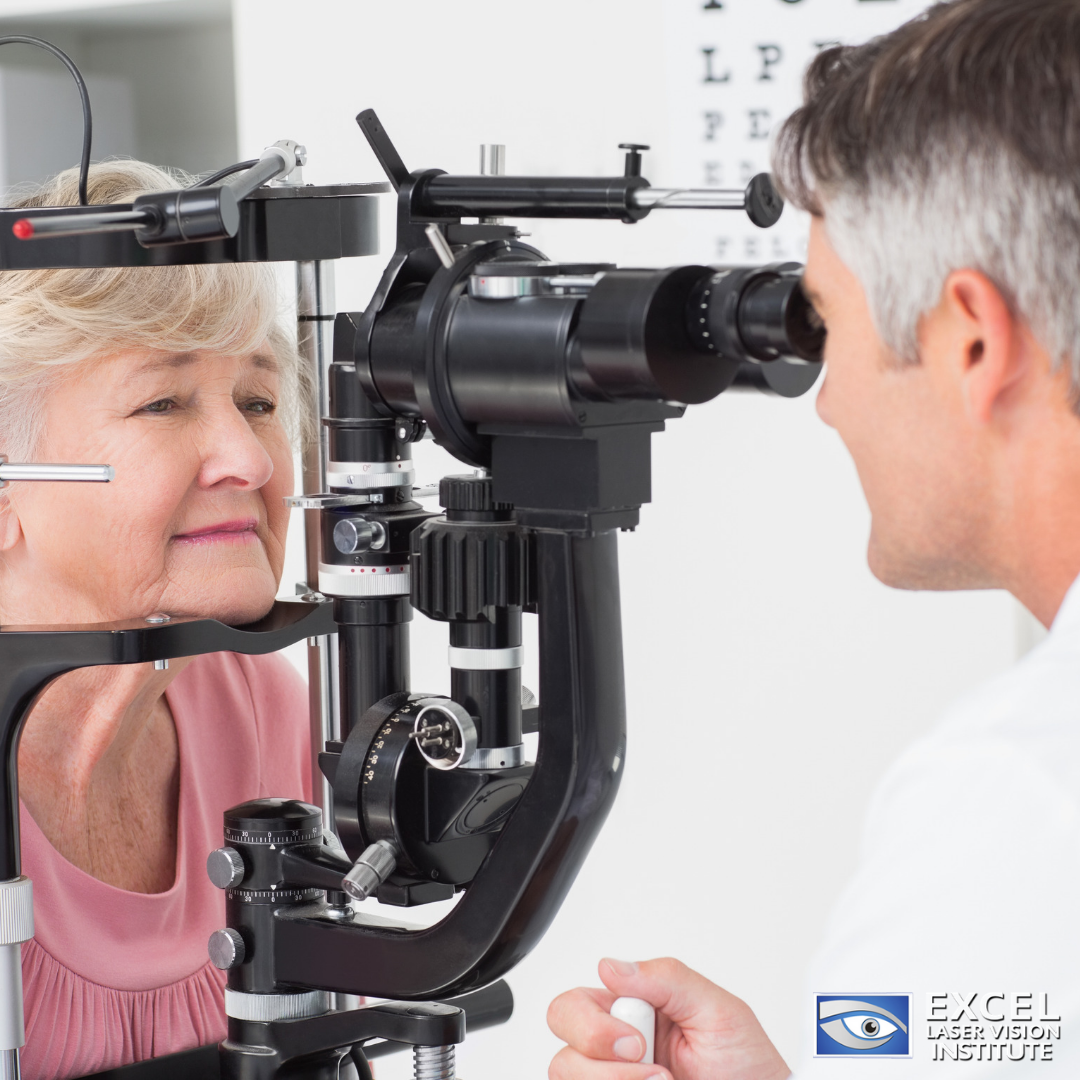
The Best Lasik Surgeons In Los Angeles Can Treat Glaucoma
The best Lasik surgeons in Los Angeles describe Glaucoma as a group of eye conditions that damage your eye’s optic nerve. Getting diagnosed in the early stages of glaucoma is important and may improve your options for treatment.
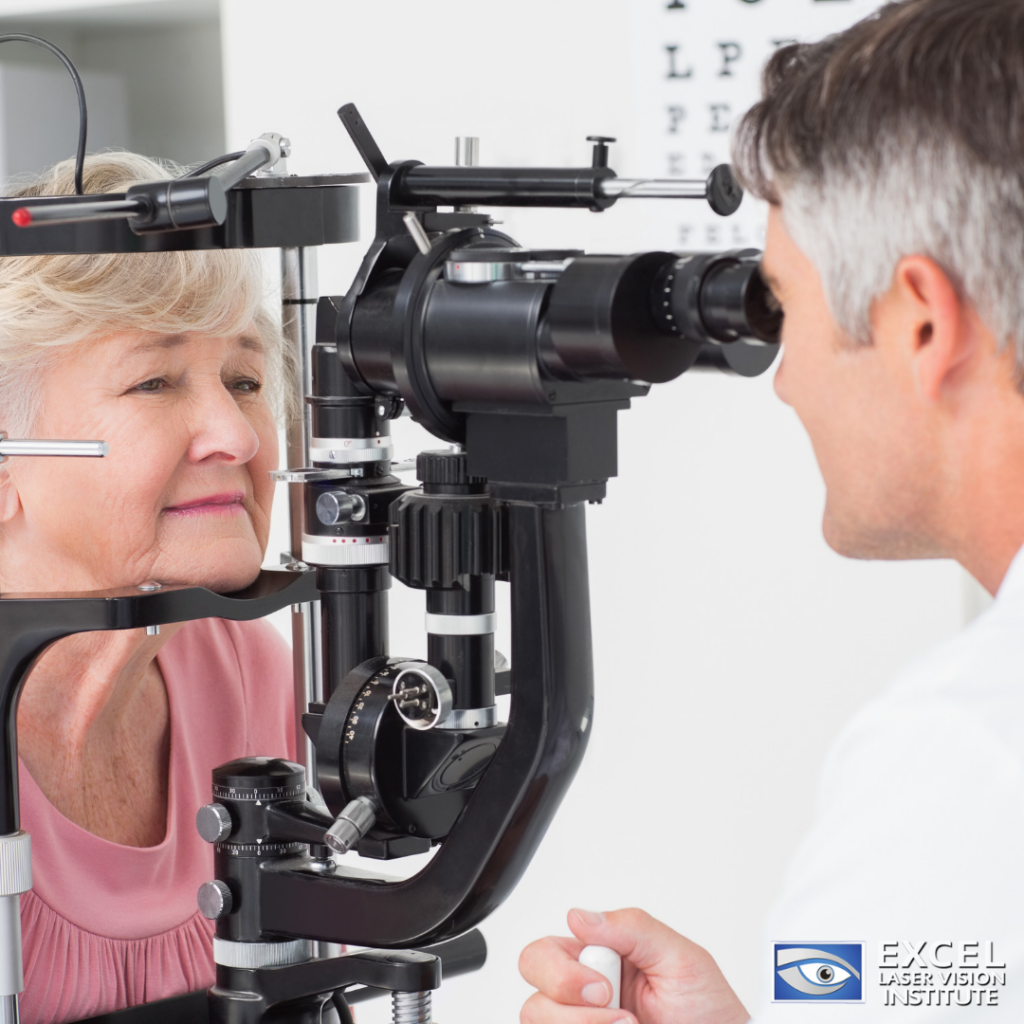
What Is Glaucoma?
In most cases, Glaucoma occurs when the pressure inside the eye is too high. The pressure can lead to damage of the optic nerve. When the optic nerve is impaired, it has a tough time transmitting images to your brain. If the damage continues, glaucoma can result in permanent vision problems and if the person neglects to receive treatment, glaucoma can result in complete blindness within a short number of years. There are varying risk factors for glaucoma. It’s sometimes inherited and could make its appearance later in life.
Some people have glaucoma and don’t even know it because early symptoms can be somewhat mild. To avoid long-term visual loss, it is advisable to visit the best Lasik surgeons in Los Angeles to provide any necessary treatment.
People who are forty years of age and over, and have a family history of glaucoma, should consider getting a thorough eye exam from an optometrist every one to two years. Also, if you have health conditions such as diabetes, or are at risk for other eye diseases, make it a point to visit your eye doctor more often.
What Causes Glaucoma?
In many circumstances, glaucoma is a result of higher than usual pressure inside the eye. This is a condition known as ocular hypertension. However, glaucoma can sometimes happen even when the pressure inside the eye, which is called intraocular pressure or “IOP” is well-adjusted. It is common to see optic nerve damage and vision loss in many types of glaucoma since the pressure inside the eye (IOP) can be extreme.
Normally, the space between the cornea (the clear front surface of the eye) and the lens inside the eye is filled with a clear fluid called aqueous humor. This fluid is responsible for feeding and caring for the inside of the anterior part of the eye. Furthermore, it keeps the shape of the eye by retaining a properly pressurized eyeball.
The ciliary body, which is located around the eye’s lens, steadily produces aqueous humor. The aqueous humor is drained from the eye through a mesh looking channel called the trabecular meshwork that is situated in the angle formed within the eye where the cornea and iris join together.
If there is a situation where the drainage angle closes down or the trabecular meshwork gets clogged, the aqueous humor cannot drain from the eye quickly enough, and the pressure inside the eye (IOP) accumulates.
On the whole, glaucoma happens when there is too much pressure inside the eye which leads to damage to the optic nerve that is located at the back of the eyeball and may cause permanent vision loss.
Further study has concluded that low intracranial pressure, which is the pressure that encircles the brain, is another risk factor for glaucoma.
What Are The Types of Glaucoma?
There are two significant types of glaucoma which are:
Primary Open-Angle Glaucoma
This is the most universal type of glaucoma. It happens slowly and is when the eye does not drain fluid properly (sort of like a backed-up drain). This leads to eye pressure building up and begins to damage the optic nerve. This type of glaucoma is painless and does not initially result in vision changes.
There are a small number of people who have optic nerves that are extremely delicate to normal eye pressure. This could signify that they are at a huge risk of developing glaucoma. These individuals should regularly have eye exams to detect early signs of damage to their optic nerve.
Angle-Closure Glaucoma (Closed-Angle Glaucoma Or Narrow-Angled Glaucoma)
This type of glaucoma usually occurs when the person’s iris is adjacent to the drainage angle within their eye. The iris starts to obstruct the drainage angle. When the drainage angle is totally closed off, eye pressure increases rapidly. This is referred to as an acute attack. This is an extreme danger to the eye, and you should get in touch with the best Lasik surgeons in Los Angeles immediately, or you will go blind.
These are the symptoms of an acute angle-closure glaucoma attack:
- Blurry vision
- Severe eye pain
- Headache
- Nausea
- Vomiting
- Seeing rainbow-colored rings or halos around lights
A lot of people with angle-closure glaucoma develop it slowly. This is known as chronic angle-closure glaucoma. In the beginning, there are no signs so these people carry on as normal until the damage is very serious or they have an attack. It is important to note that angle-closure glaucoma can result in blindness if not treated immediately.
How Does An Optometrist Treat Glaucoma?
Surgery is not the only method of treating glaucoma. Various treatment methods depend on the severity and how early on you got diagnosed. Treatments for glaucoma can include medicated eye drops, microsurgery, laser treatments, and of course other forms of eye surgery.
You should know that glaucoma treatments can avoid more vision loss, but they cannot restore the vision that has already been lost because of the disease.
Based on the type, how severe your glaucoma is, and how your eyes respond to glaucoma treatment, your ophthalmologist may prescribe medical treatment, surgery, or a mix of both.
If you’re diagnosed with glaucoma in its early stages, your eye doctor will most likely prescribe a topical medication, which usually comes in the form of eye drops. The goal of glaucoma eye drops is to lower IOP so you avoid vision loss.
In serious cases, glaucoma surgery is often a better alternative than medication to manage glaucoma and prevent vision loss. If you are experiencing any of the symptoms listed above, or have a family history of glaucoma, get in touch with Excel Laser Vision Institute at + (818) 907-8606 to schedule your free eye evaluation today!
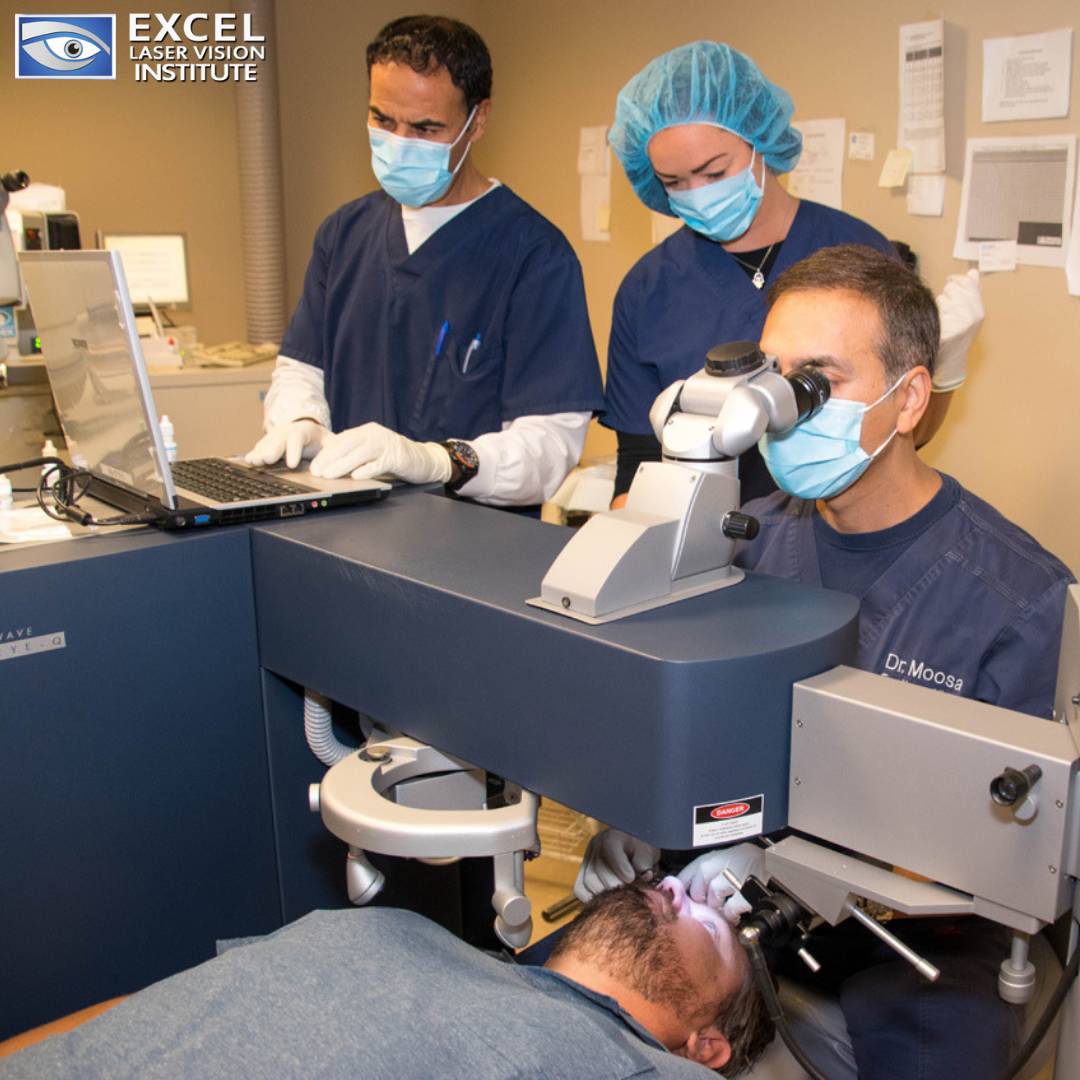
What Are Eye Floaters?
Are you seeing little spots, specks, and spider webs floating randomly within your area of vision? Although they are a nuisance, a lasik surgeon in Orange County says that eye floaters and spots are extremely common and usually aren’t much to worry about.
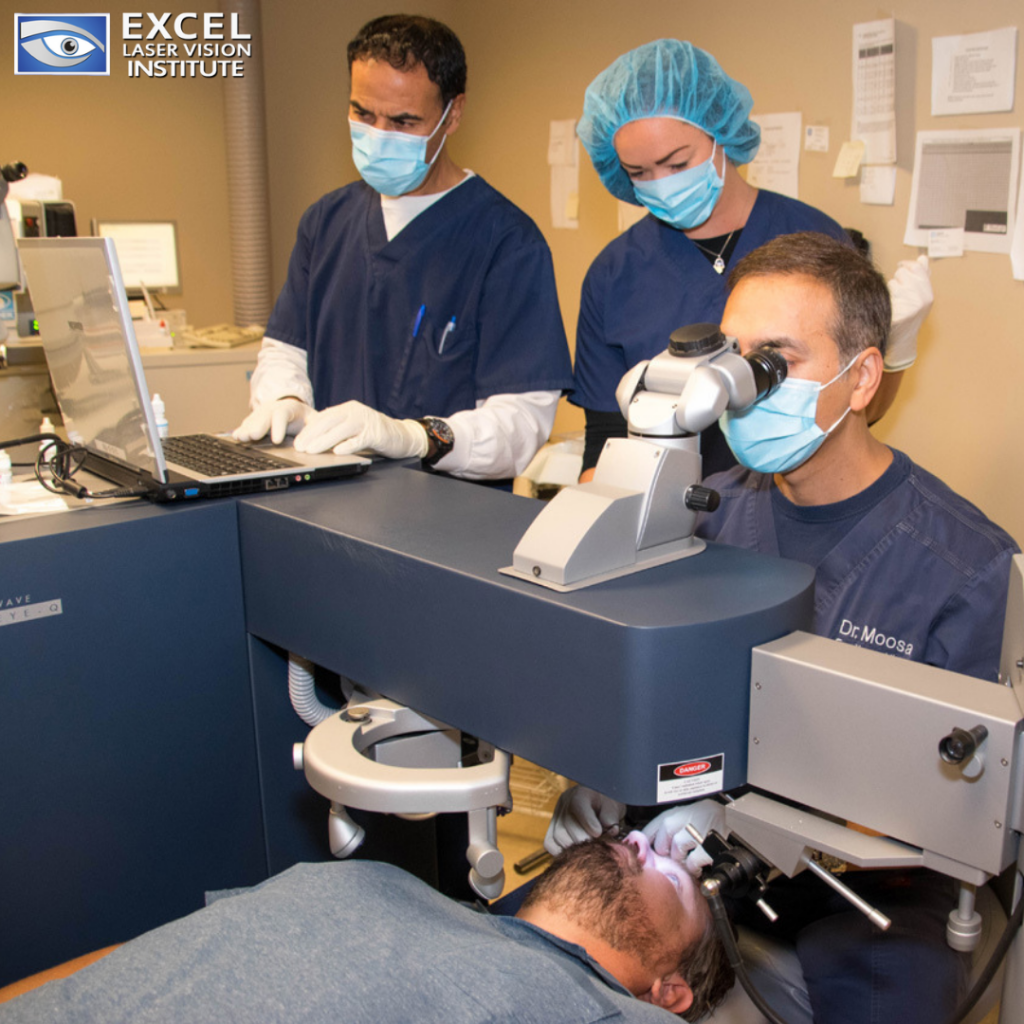
What Are The Symptoms of Eye Floaters?
Floaters have earned their name by, you guessed it, floating around the eye. They tend to bound and dash away when you make an effort to focus on them.
They come in many different sizes and shapes such as the following:
- Rings
- Squiggly lines
- Cobwebs
- Threadlike strands
- Black or grey dots
When you get them, they initially might not flee easily but over time, more than likely, you will notice them less.
What Causes Eye Floaters?
You get floaters and spots in your vision when pieces of the eye’s gel-like vitreous gets within the back part of your eye. At birth and throughout our younger years, the vitreous has a gel-like consistency. However, as we age, the vitreous starts to break down and liquefy creating a watery center.
Some of these undissolved gel particles periodically make their way into the liquid center of the vitreous and begin to float there. These particles are what the lasik surgeon in Orange County refer to as “eye floaters”.
These spots and eye floaters are usually very noticeable if you stare at a clear or overcast sky, or even a computer screen that has a white or light-colored background. You can’t actually see the tiny bits of debris drifting inside your eye. What you are seeing are the shadows these floaters cast on the retina as light passes through the eye.
You probably have a tough time focusing on these specks, since they never want to stay still. The reason for this is the floaters and spots move around when the eye and the vitreous gel shift, creating the effect that they are moving about aimlessly.
What Causes Eye Flashes?
Normally, light entering the eye stimulates the retina. This creates an electrical impulse, which the optic nerve sends to the brain. The brain then translates this impulse as light or some kind of image.
In the event that the retina is mechanically stimulated (physically touched or pulled), an identical electrical impulse is transmitted to the brain. The impulse is then interpreted as a flicker of light.
As soon as the retina is pulled, torn or detached from the back of the eye, the person affected will begin to notice a flash or flicker of light. The severity of the flashes and how short-lived or persistent they are depends on the extent of the traction, tear or detachment. These flashes usually continue until the retina is repaired.
Flashes, or photopsia, can also happen after a knock to the head shakes the vitreous gel inside the eye. When this happens, the person might experience “seeing stars”.
When Are Eye Floaters And Flashes a Cause For Concern?
Our lasik surgeon in Orange County advises to not be alarmed when you see some floaters every now and then. However, if you experience a downpour of floaters and spots followed by flashes of light, you should talk to an optometric physician.
The unexpected manifestation of these symptoms could signal that the vitreous has disconnected itself from your retina. This condition is known as posterior vitreous detachment. It means that the retina has possibly been knocked loose from the inner lining in the back of the eye. This lining is responsible for holding blood, nutrients, and oxygen that are important to healthy eye functions.
While the vitreous gel pulls on the fragile retina, a small tear or hole can develop. When the retina is damaged, vitreous can get into the opening and push the retina from the inner lining located at the back of the eye. This can cause retinal detachment.
A study published in Ophthalmology revealed that 39.7 percent of individuals who experienced the immediate symptoms of eye floaters and/or flashes of light, had a posterior vitreous detachment and 8.9 percent of them had a torn retina.
Further research discovered that approximately 50 percent of individuals with a retinal tear would go on to develop a detachment of the retina, resulting in considerable vision loss.
When retina tears or detachments occur, treatment must take place almost immediately in order for an eye surgeon to attempt to reattach the retina and regain eye function before vision is severely impacted.
Laser Treatment for Eye Floaters
A new laser procedure called laser vitreolysis is an excellent way to treat eye floaters. This is a safe and effective in-house procedure in which a laser beam is projected through the pupil and focused on large floaters. This breaks them down and/or sometimes vaporizes the floaters so they vanish or become less of a nuisance.
To find out whether you can benefit from laser eye treatment for eye floaters, or need a medical evaluation for eye flashes, get in touch with Excel Laser Vision Institute at + (818) 907-8606 to schedule a free eye examination. Board-certified ophthalmologist and respected Lasik surgeon Dr. Ferzaad Moosa will help you get the clear vision you want with effective state-of-the art laser eye treatment!

